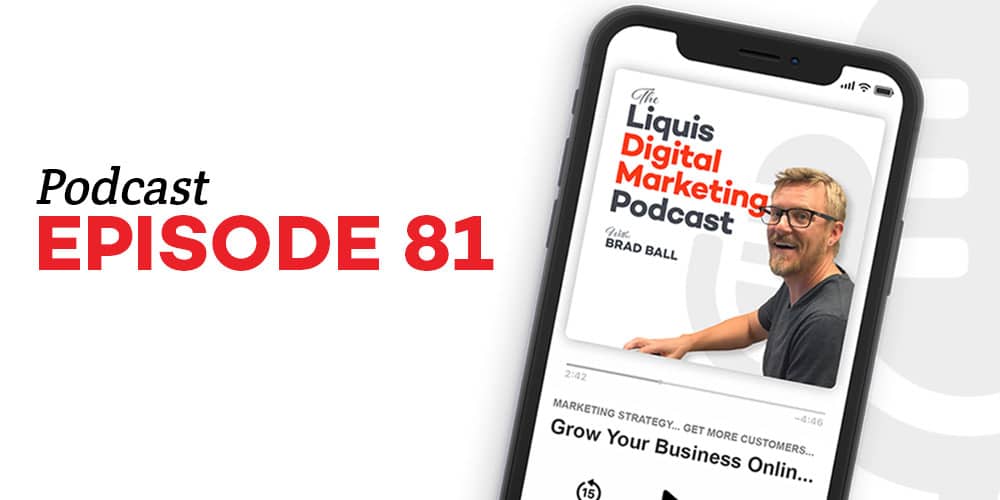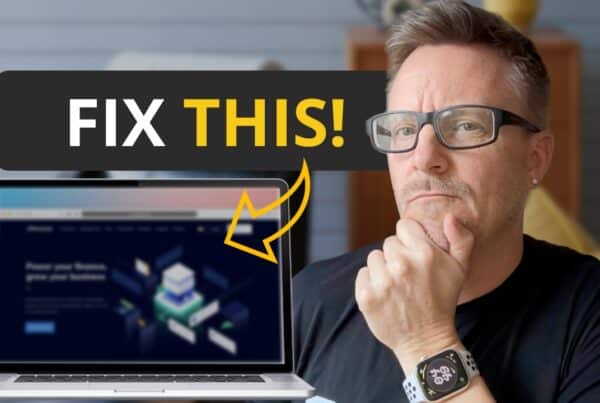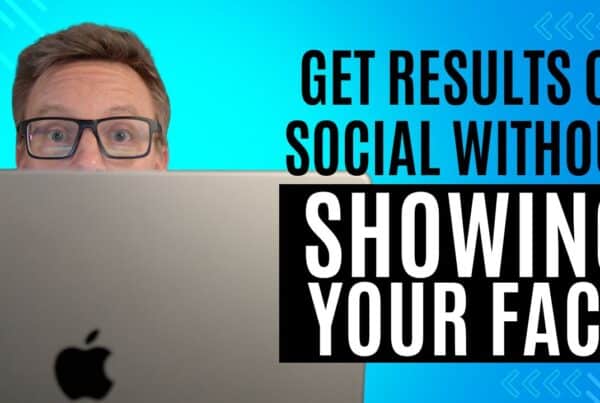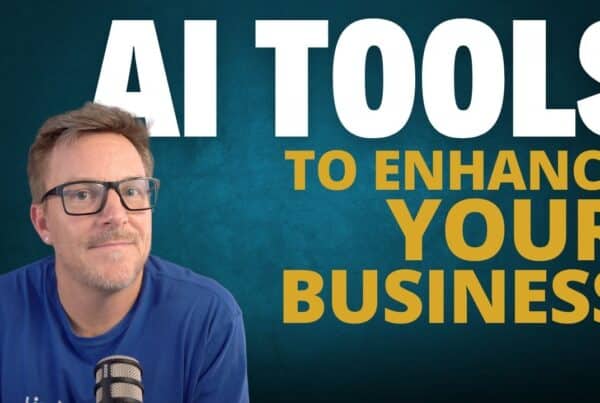Show Notes
Why are you not getting more customers from your website? I talk to a lot of businesses and most of the time this is what I hear:
“I don’t really get customers from my website. It’s just there incase people want to check us out.”
Does that sound familiar?
Look, just because you’re not getting customers from your website, doesn’t mean you couldn’t be.
In this episode, we’re talking about why you’re not getting customer from your website and what you can do about it!
Discussion Topics:
- Your call to actions
- Clarifying your messaging
- Why your losing 90% of your visitors
Resources:
- Website Makeover Checklist: https://liquisdigital.com/resources/lead-gen-checklist/
- Facebook Group: https://www.facebook.com/groups/motivatedbusinessowners
- Subscribe to our YouTube Channel: https://www.youtube.com/c/Liquisdesign?sub_confirmation=1
Why you’re not getting customers from your website
EP81 – Transcript
[00:00:00] Why are you not getting more customers from your website? I talk to a lot of businesses and most of the time, this is what I hear. I don’t really get customers from my website. It’s just there in case people wanna check us out. Does that sound familiar? Look, just because you’re not getting customers from your website doesn’t mean you couldn’t be.
[00:00:20] In this episode, we’re talking about why you are not getting customers from your website and what you can do about it.
[00:00:31] Welcome to the Liquis Digital Marketing Podcast, where each week we’ll be breaking down complex marketing topics into bite size steps you can take now to grow a profitable. For your business, we’ll discuss organic reach, offer optimization, paid advertising, email marketing, content creation, promotion techniques, and so much more.
[00:00:50] I’m your host, Brad Ball, founder of Liquis Digital, a marketing agency that has helped hundreds of clients of every shape and size reach their business goals since 2008. Thanks for joining us today, and be sure to subscribe because you won’t want to miss a beat. Now, let’s grow.
[00:01:09] Hello, and welcome back to another episode of the Liquis Digital Marketing Podcast. In this episode, we are talking about why you’re not getting customers from your website. One of the main reasons we see people not getting customers from their website is quite frankly, an easy, easy fix, and. Having the right and having call to actions on your website.
[00:01:35] So a research study recently found that over 70% of small businesses don’t use call to action buttons on their website. What is a call to action button, or I guess a call to action? Typically, it’s in the form of a button. What this is, is basically a prompt telling your visitor what action you want them to take.
[00:01:57] It’s a call to action. You’re calling them to take an action. So typically what people will have is on their forms, like a submit button or a contact us link or something like that, right? So that would be a call to action, but actually a very bad call to action when we’re thinking about call to actions.
[00:02:16] What is a good call to action? So a good call to action is something that is going to compel someone. Take that action. So maybe that action is to schedule a demo or to start their free trial or to schedule a consultation or a free strategy call or something. So where should you put these call to actions on your website?
[00:02:44] One of the main places is in the top header, right? So typically on a website, what you would see when you first go to it is at the very top, you have your header, it’s gonna have your logo and your navigation. Usually the logo’s on the left and the navigation’s on the right. And this is because this is the way people skim websites.
[00:03:02] What I always recommend is to have that call to action up at the very top right part of your header. So usually it’s in the form of a, a button that has some like contrast or stands out from the rest of the navigation. And usually what you want is one main call to action on your website. So whether that’s a contact us or uh, book a demo.
[00:03:28] Or sign up today, or whatever it is, whatever that main thing you want them to do, that should be your main call to action. The next place you should have it is in the hero section, right? So right underneath the header you have that big area that we call the hero section. Usually there’s like a video background or an image or some space, and then you have a title, and then you have a call to action, a button, schedule your demo, learn more, you know, get your free trial, whatever it is, right?
[00:04:00] That is your call to action. Definitely have it in the header. In the hero section, and then you wanna have it sprinkled throughout the rest of your page where it makes sense. So maybe next to testimonials, or maybe it’s right after you list all of the services or the benefits, right? So this is, you just wanna have that same call to action again and again throughout.
[00:04:24] I also recommend having it in your global footer. So the footer is basically the opposite of the header and it’s at the very bottom. Having a section above, you know, the, the footer where you usually have like a logo and links and all of that fun stuff. Um, right above that you can just have a, like a call to action that just hits every page and, you know, it could have some, some verbiage next to it with a button.
[00:04:47] That’s your call to action. That’s where you’d wanna put it. Now when you are making your button or your call to action, here are some tips to making it better and more compelling. First off, make sure that your call to action button stands out, like create contrast. So if it’s on a dark background, make it white.
[00:05:09] If it’s on a light background, make it your primary color. Like make it bold. Make it different than the rest of the elements around it, right? So make it stand out. This is creating contrast. When you put the verbiage on this button, don’t just have, submit or contact us or learn more, use better language such as strong verbs.
[00:05:34] Like use the word bi or download or order. Like put the action, put a verb into the action. What’s the action you want them to take? Right? Put that in there. Next is you want to provoke an emotion. So if you can think through it, like, okay, plan your dream vacation today. Right? So you’re, you’re provoking some like emotion out of them.
[00:05:59] Like, oh yeah, okay, let’s get that dream vacation going right. . Another technique is to use fomo. Fear of missing out. So while supplies last, the deal ends today, you know, things like that is gonna help people to take that action. The other tip is to use first person. An example would be, yes, send me my free guide or get my free 40% off code.
[00:06:27] Right? So it’s kind of like your first person. Because if you think about it, the psychology, when someone’s reading the site, they’re reading it from their perspective. So if it’s you get your, then you’re talking to them. If it’s them reading it, my, then it’s them talking to themselves. So it’s more convincing.
[00:06:45] They’re convincing themselves. Right. Okay. So that’s the call to actions. So go through your site and get your call to actions. Right. The next thing, and this is a big one, and that is clarifying your message. So this is where a lot of people fail. We just actually did an episode not too long ago, episode 77, where we really dive into clarifying your message and we’re gonna highlight some of that stuff here.
[00:07:07] But I highly recommend going back and looking or looking, listening to that episode or that video, and seeing, you know, what we talked about there. Because we dive deeper into this. So clarifying your message. So first off, we kind of talked about this already. Your hero section, that area right underneath your main navigation.
[00:07:23] It’s really the most important real estate on your website. It’s on your homepage. It’s the top area. It’s where people see and what they see first. What this section needs to do is it needs to convey this message. It needs to tell them what you do, what problem you solve, and what action you want them to take.
[00:07:42] It needs to be very clear on what those elements are. Don’t put a welcome or, uh, your journey starts here. This vague, cutesy messaging that really does nothing. It tells them nothing. They need to, in seven seconds, be able to tell what you do, what problem you solve, and what action you want them to take Very clearly.
[00:08:08] The content should be focused on them, not about you. So if your sentence says, we blah, blah, blah, blah, you’ve already messed it up, right? It’s not about you, it’s about them. So research, go. Actually go listen to our previous podcast where we kind of dive deeper into that, uh, episode 77. And if you have questions, let me know.
[00:08:29] I will help you craft that statement. It’s the most important statement on your. So the next thing to do when it comes to clarifying your messaging is really, yes, it does apply to your website, but this really actually applies to everything in your business, from your social media bios, to the social media posts, to the emails you write, to the content you create for your website.
[00:08:51] Everything, these three items, First one is your messaging statement. So for example, we work with this type of person who struggles with this specific problem and wants to have this result. Instead, if you can develop that statement, it’s really your elevator pitch. It’s really your why. It’s really like what you do, right?
[00:09:17] It’s how you help people, and it’s why people should. The next thing is your through line. So this is answering the question, what do people need to believe in order to feel that your services are the answer? Right? So once you understand that, the answer to that question, that is really kind of the, the premise and the content, the, the approach you take to all of your messaging throughout your.
[00:09:44] And then the last one of these messaging statements is the ultimate outcome. So this is really why they should truly care about what you have to say. We’re gonna help you with your solution so that you can, in so life changing events, outcomes, or benefits. The key in this sentence is the word. So you can, you have to have, so you can, in this statement, moving.
[00:10:10] The fact is, the reason why people are not taking action on your website is because 90% of people visiting your website are just not ready to take action. And if your one call to action is for them to take an action, they’re not ready to take. You’ve lost them. So here’s my recommendation. Create a secondary call to action, an easier barrier to entry.
[00:10:33] Something that they do want, something of value, something easy. Where it’s basically an exchange of their email address for some piece of value with this email address. Now you can build your list and continue the conversation with them. So basically this is by using a, what we call a lead magnet, and it’s maybe a checklist or a free guide where we’ve all seen ’em, right.
[00:10:58] It’s something that yes, they’re interested in. Okay, yeah, I’ll give you my email address and now you can continue that conversation. Now you can give them more information, build trust and credibility with them. So they start to know, like, and trust you. And then 90% starts to turn into maybe 70% or 50% will eventually turn into buyers.
[00:11:20] Today’s email list is tomorrow’s buyers, so get those emails and the best way it is with the lead. All right guys, so that is some simple ways to update your website and to start getting customers from your website. Your website does not need to be just a pretty thing that’s out there on the web taking up space.
[00:11:41] It can actually bring you customers. Make these changes and let me know how it goes. Don’t forget to join our free Facebook group where we do di dive deeper into these topics and um, it’s a place for us to. Outside of this podcast, it’s full of other like-minded business owners. I’d love to see you there, the links in the, uh, show notes of this or the description of this, and we’ll see you in the next episode.
[00:12:07] Thanks for listening in today. I hope you enjoyed the show. And hey, if you did, please take a second to leave a review and share this episode with someone who you think might also benefit from it. I appreciate you so much, and as always, we’re here to help. If you have any questions about this, Or want to talk strategy with us about your own project, just shoot us an email to info Liquis Digital dot com and we’ll catch you in the next episode.




